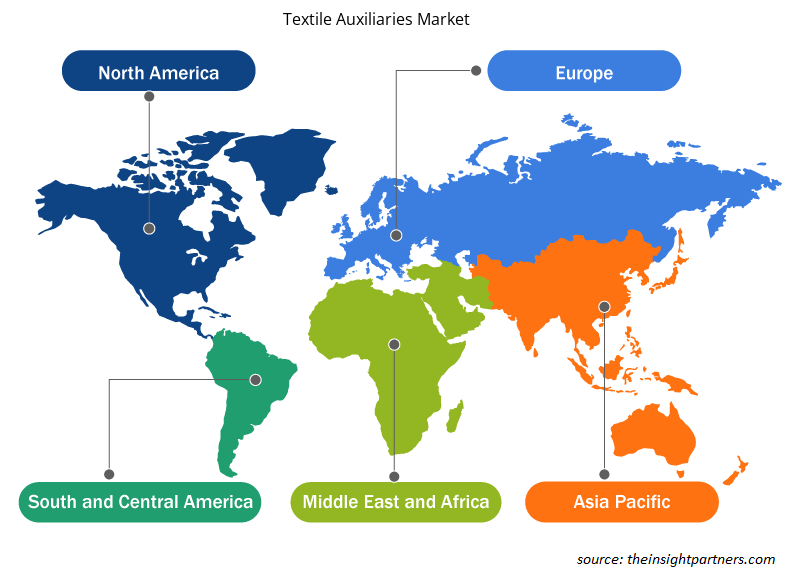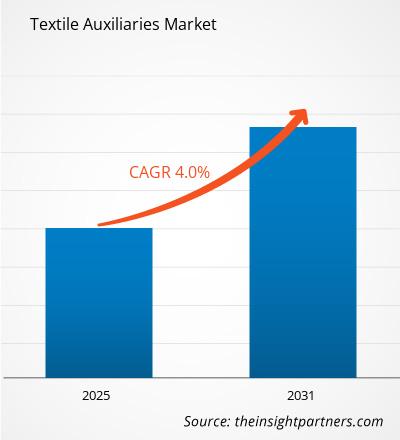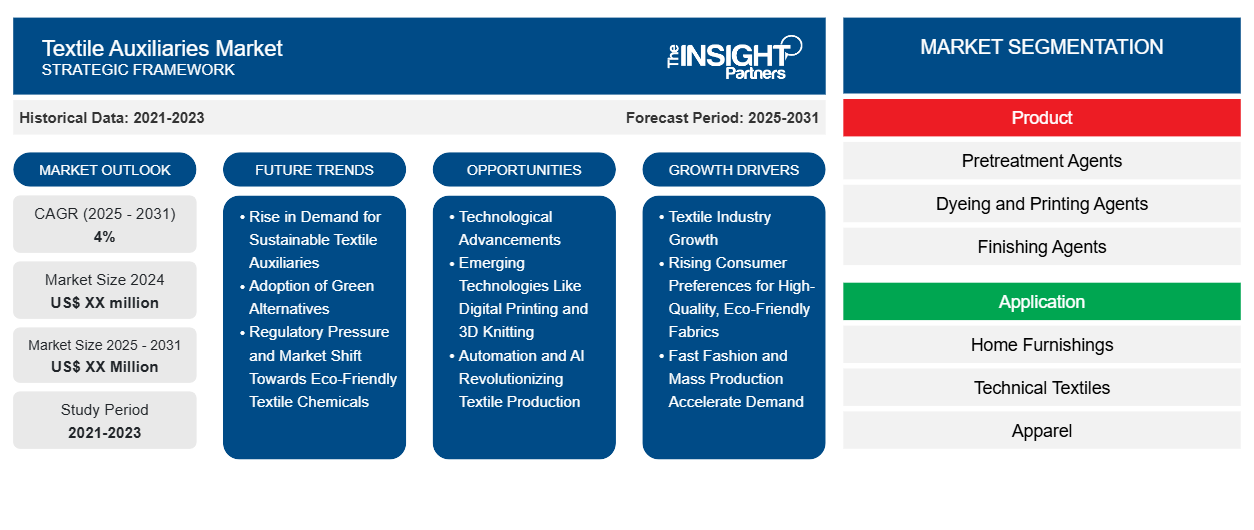من المتوقع أن يسجل سوق المواد المساعدة في المنسوجات معدل نمو سنوي مركب بنسبة 4٪ من عام 2024 إلى عام 2031، مع توسع حجم السوق من XX مليون دولار أمريكي في عام 2024 إلى XX مليون دولار أمريكي بحلول عام 2031.
يقدم التقرير تحليلاً يعتمد على المنتج (عوامل المعالجة المسبقة، وعوامل الصباغة والطباعة، وعوامل التشطيب، وتشطيب الغزل، والحياكة والنسيج، وغيرها). يتم تقسيم التقرير حسب التطبيق (مفروشات المنزل، والمنسوجات الفنية، والملابس، والمنسوجات الصناعية). يتم تقسيم التحليل العالمي بشكل أكبر على المستوى الإقليمي والدول الرئيسية. يتم تغطية حجم السوق والتوقعات على المستويات العالمية والإقليمية والقطرية لجميع قطاعات السوق الرئيسية ضمن النطاق. يقدم التقرير القيمة بالدولار الأمريكي للتحليل والقطاعات المذكورة أعلاه. يقدم التقرير إحصائيات رئيسية عن حالة السوق للاعبين الرئيسيين في السوق ويعرض اتجاهات السوق والفرص.
غرض التقرير
يهدف تقرير سوق المواد المساعدة للمنسوجات الصادر عن The Insight Partners إلى وصف المشهد الحالي والنمو المستقبلي وأهم العوامل الدافعة والتحديات والفرص. وسيوفر هذا رؤى لمختلف أصحاب المصلحة في الأعمال التجارية، مثل:
- مزودي/مصنعي التكنولوجيا: لفهم ديناميكيات السوق المتطورة ومعرفة فرص النمو المحتملة، وتمكينهم من اتخاذ قرارات استراتيجية مستنيرة.
- المستثمرون: إجراء تحليل شامل للاتجاهات فيما يتعلق بمعدل نمو السوق، وتوقعات السوق المالية، والفرص المتاحة عبر سلسلة القيمة.
- الهيئات التنظيمية: لتنظيم السياسات ومراقبة الأنشطة في السوق بهدف تقليل الانتهاكات والحفاظ على ثقة المستثمرين والحفاظ على سلامة السوق واستقرارها.
تجزئة سوق المواد المساعدة للمنسوجات
منتج
- عوامل المعالجة الأولية
- مواد الصباغة والطباعة
- عوامل التشطيب
- الانتهاء من الدوران
- الحياكة والنسيج
طلب
- مفروشات المنزل
- المنسوجات التقنية
- ملابس
- المنسوجات الصناعية
قم بتخصيص هذا التقرير ليناسب متطلباتك
ستحصل على تخصيص لأي تقرير - مجانًا - بما في ذلك أجزاء من هذا التقرير، أو تحليل على مستوى الدولة، وحزمة بيانات Excel، بالإضافة إلى الاستفادة من العروض والخصومات الرائعة للشركات الناشئة والجامعات
- احصل على أهم اتجاهات السوق الرئيسية لهذا التقرير.ستتضمن هذه العينة المجانية تحليلاً للبيانات، بدءًا من اتجاهات السوق وحتى التقديرات والتوقعات.
محركات نمو سوق المواد المساعدة للمنسوجات
- نمو صناعة النسيج: يعد النمو في صناعة النسيج أحد المحركات الرئيسية لسوق المواد المساعدة للنسيج، حيث تلعب هذه المواد الكيميائية دورًا مهمًا في مراحل مختلفة من إنتاج الأقمشة. تعمل المواد المساعدة للنسيج على تحسين جودة الأقمشة وأدائها ومظهرها، وبالتالي فهي ضرورية لعمليات التصنيع مثل الصباغة والتشطيب والطباعة. إن الطلب المتزايد على المنتجات النسيجية يدفع السوق إلى الأمام.
- تفضيلات المستهلكين المتزايدة للأقمشة عالية الجودة والصديقة للبيئة: مع تفضيلات المستهلكين المتزايدة للأقمشة عالية الجودة وطويلة الأمد والصديقة للبيئة، زاد الطلب على المواد المساعدة للنسيج المتخصص. يتم تطبيق هذه المواد الكيميائية لرفع خصائص النسيج مثل ثبات اللون والنعومة ومقاومة الماء، والتي أصبحت بشكل متزايد مصدرًا لطلب المستهلكين.
- الموضة السريعة والإنتاج الضخم يسرعان الطلب: لقد أبرزت الزيادة السريعة في الموضة السريعة والإنتاج الضخم السعي إلى إيجاد مساعدات نسيجية لتسريع الطلب. ومع ارتفاع معدلات الإنتاج في المنافسة وزيادة متطلبات مجموعة واسعة من الأقمشة العصرية المتنوعة، فإن المساعدين الذين يحققون كفاءة إنتاج أعلى مع انخفاض التدهور البيئي يتزايدون. وهذا يتسبب في المزيد من الاستثمارات في المساعدين المتطورين لترقية عملية معالجة الأقمشة وإنتاجها.
الاتجاهات المستقبلية لسوق المواد المساعدة في المنسوجات
- ارتفاع الطلب على المواد المساعدة المستدامة في صناعة المنسوجات: أصبحت المواد المساعدة المستدامة في صناعة المنسوجات رائجة، حيث أصبح العديد من المستخدمين الصناعيين والأفراد يستخدمون المواد الصديقة للبيئة. وهم يتحولون الآن إلى المواد الكيميائية الصديقة للبيئة وبالتالي يقللون من التأثيرات البيئية. وهذا ما يدفع الشركات المصنعة إلى ابتكار بدائل أكثر خضرة في تبني عمليات إنتاج المنسوجات.
- تبني البدائل الخضراء: لقد تبنت المواد المضافة الخضراء الخالية من التلوث والمنتجات الثانوية السامة، والمواد الكيميائية المستخدمة في المياه الأساسية، أو المواد المساعدة القابلة للتحلل البيولوجي مثل هذه الاتجاهات للحد من تدفق المنتجات الثانوية السامة والتلوث. وهذا يعني أنها لن تتوافق مع اللوائح البيئية فحسب، بل إنها ستجذب أيضًا المستهلكين الذين يفضلون المنتجات المصنعة باستخدام التكنولوجيا الخضراء. "هذا الطلب يخلق مستقبلًا لسوق المواد المساعدة للمنسوجات".
- الضغوط التنظيمية وتحول السوق نحو المواد الكيميائية الصديقة للبيئة المستخدمة في صناعة المنسوجات: بالإضافة إلى هذا الزخم لتطبيق مستويات أعلى، تضع المنظمات والحكومات على مستوى العالم سياسات بيئية صارمة تتوقع من خلالها الحد من البصمة الكربونية لشركات تصنيع المنسوجات. وسوف تعمل الضغوط المتزايدة من المعايير البيئية على تعزيز استخدام المواد الكيميائية الخضراء أو الصديقة للبيئة في عمليات تصنيع المنسوجات التي تنطوي على تقنيات تستهلك كميات أقل من المياه والطاقة كجزء من ممارسات التصنيع الخضراء. ونتيجة لهذا، يستثمر اللاعبون في السوق جهودًا إضافية للبحث وتطوير حلول أكثر استدامة تلبي احتياجات المستهلكين والمعايير.
فرص سوق المنتجات المساعدة في المنسوجات
- التقدم التكنولوجي: لا شك أن التقدم التكنولوجي هو العامل الرئيسي الدافع وراء خلق المزيد من فرص النمو لسوق المواد المساعدة للنسيج. وقد أدى التقدم في التركيبات الكيميائية إلى إنتاج مواد مساعدة للنسيج ذات أداء أفضل ووظائف وظيفية أفضل. بالإضافة إلى ذلك، تمكن مثل هذه التطورات من إنتاج منسوجات متينة وناعمة ومقاومة للماء وفقًا لتفضيلات المستهلك.
- التقنيات الناشئة مثل الطباعة الرقمية والحياكة ثلاثية الأبعاد: علاوة على ذلك، قد تستفيد صناعة النسيج من ظهور تقنيات جديدة تمامًا في معالجة المنسوجات، مثل الطباعة الرقمية والحياكة ثلاثية الأبعاد، والتي تتطلب أنواعًا معينة من الأدوات المساعدة لتحسين أدائها. ومع تقدم هذه التقنيات، فإن الطلب المتزايد على الحلول المساعدة فيما يتعلق بوظائفها وتوافقها مع الميزات في التعامل مع العمليات المعقدة للاستفادة من الناتج عالي الجودة من شأنه أن يوفر مساحة عمل جيدة للمصنعين.
- الأتمتة والذكاء الاصطناعي يُحدثان ثورة في إنتاج المنسوجات: في الواقع، أصبحت صناعة المنسوجات أكثر ديمقراطية نتيجة لعمليات الإنتاج الأكثر كفاءة التي أصبحت ممكنة بفضل الأتمتة والذكاء الاصطناعي. ونتيجة لذلك، تزداد شعبية عملية الإنتاج بسبب الأنظمة الآلية، بينما يزداد الطلب على فئة المنتجات المساعدة، مما يدعم عمليات الإنتاج الفعالة والسريعة والفعّالة من حيث التكلفة. كل هذه التطورات تجعل السوق أكثر تنافسية من خلال خلق سيناريو للابتكار والطلب على المواد الكيميائية المتخصصة في صناعة المنسوجات.
رؤى إقليمية حول سوق المواد المساعدة في المنسوجات
لقد قام المحللون في Insight Partners بشرح الاتجاهات والعوامل الإقليمية المؤثرة على سوق المواد المساعدة للمنسوجات طوال فترة التوقعات بشكل شامل. يناقش هذا القسم أيضًا قطاعات سوق المواد المساعدة للمنسوجات والجغرافيا في جميع أنحاء أمريكا الشمالية وأوروبا ومنطقة آسيا والمحيط الهادئ والشرق الأوسط وأفريقيا وأمريكا الجنوبية والوسطى.

- احصل على البيانات الإقليمية المحددة لسوق المواد المساعدة للمنسوجات
نطاق تقرير سوق المواد المساعدة للمنسوجات
| سمة التقرير | تفاصيل |
|---|---|
| حجم السوق في عام 2024 | XX مليون دولار أمريكي |
| حجم السوق بحلول عام 2031 | XX مليون دولار أمريكي |
| معدل النمو السنوي المركب العالمي (2024 - 2031) | 4% |
| البيانات التاريخية | 2021-2023 |
| فترة التنبؤ | 2025-2031 |
| القطاعات المغطاة | حسب المنتج
|
| المناطق والدول المغطاة | أمريكا الشمالية
|
| قادة السوق وملفات تعريف الشركات الرئيسية |
|
كثافة اللاعبين في سوق المنتجات المساعدة للمنسوجات: فهم تأثيرها على ديناميكيات الأعمال
يشهد سوق المواد المساعدة للمنسوجات نموًا سريعًا، مدفوعًا بالطلب المتزايد من المستخدم النهائي بسبب عوامل مثل تفضيلات المستهلك المتطورة والتقدم التكنولوجي والوعي المتزايد بفوائد المنتج. ومع ارتفاع الطلب، تعمل الشركات على توسيع عروضها والابتكار لتلبية احتياجات المستهلكين والاستفادة من الاتجاهات الناشئة، مما يؤدي إلى زيادة نمو السوق.
تشير كثافة اللاعبين في السوق إلى توزيع الشركات أو المؤسسات العاملة في سوق أو صناعة معينة. وهي تشير إلى عدد المنافسين (اللاعبين في السوق) الموجودين في مساحة سوق معينة نسبة إلى حجمها أو قيمتها السوقية الإجمالية.
الشركات الرئيسية العاملة في سوق المواد المساعدة للنسيج هي:
- هانتسمان الدولية المحدودة
- سولفاي
- أركروما
- شركة داو للكيماويات
- زشيمر وشوارتز
إخلاء المسؤولية : الشركات المذكورة أعلاه ليست مرتبة بأي ترتيب معين.

- احصل على نظرة عامة على أهم اللاعبين الرئيسيين في سوق المواد المساعدة للمنسوجات
نقاط البيع الرئيسية
- التغطية الشاملة: يغطي التقرير بشكل شامل تحليل المنتجات والخدمات والأنواع والمستخدمين النهائيين لسوق المساعدات النسيجية، مما يوفر صورة شاملة.
- تحليل الخبراء: تم تجميع التقرير على أساس الفهم العميق لخبراء الصناعة والمحللين.
- معلومات محدثة: يضمن التقرير أهمية الأعمال التجارية بسبب تغطيته للمعلومات الحديثة واتجاهات البيانات.
- خيارات التخصيص: يمكن تخصيص هذا التقرير لتلبية متطلبات العملاء المحددة وبما يتناسب مع استراتيجيات العمل بشكل مناسب.
وبالتالي، يمكن أن يساعد تقرير البحث حول سوق المواد المساعدة في المنسوجات في تمهيد الطريق لفك شفرة وفهم سيناريو الصناعة وآفاق النمو. ورغم وجود بعض المخاوف المشروعة، فإن الفوائد الإجمالية لهذا التقرير تميل إلى التفوق على العيوب.
- التحليل التاريخي (سنتان)، سنة الأساس، التوقعات (7 سنوات) مع معدل النمو السنوي المركب
- تحليل PEST و SWOT
- حجم السوق والقيمة / الحجم - عالمي، إقليمي، بلد
- الصناعة والمنافسة
- مجموعة بيانات إكسل
التقارير الحديثة
شهادات العملاء
سبب الشراء
- اتخاذ قرارات مدروسة
- فهم ديناميكيات السوق
- تحليل المنافسة
- رؤى العملاء
- توقعات السوق
- تخفيف المخاطر
- التخطيط الاستراتيجي
- مبررات الاستثمار
- تحديد الأسواق الناشئة
- تحسين استراتيجيات التسويق
- تعزيز الكفاءة التشغيلية
- مواكبة التوجهات التنظيمية





















 احصل على عينة مجانية ل - سوق المنسوجات المساعدة
احصل على عينة مجانية ل - سوق المنسوجات المساعدة